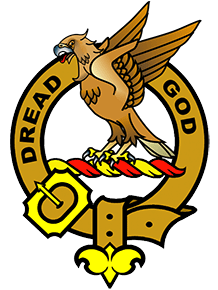Munro Clan
Munro Clan Crest: A perching eagle.
Munro Clan Motto: Dread God.
History of Clan Munro:
There is a tradition that the ancestors of the Munros originated from the River Roe in Derry, Ireland. Coming to Scotland, they became vassals of the earldom of Ross, and Robert de Munro had a Charter from Robert I for “Counetis in Strathspey and Cupermakcultis.” Clan Munro territory was on the north side of the Cromarty Firth, but, by the 14th century, their lands also encompassed Loch Broom.
Donald Munro, who succeeded his father in 1164, is said to have built the Tower of Foulis, obviously as a fortification as the walls at ground level are five foot six inches thick. He is thought to have been given the lands by Malcolm II as a reward for repelling invaders from Scandinavia. Thereafter, the Clan appeared at the Battle of Bannockburn in 1314, and at the Battle of Halidon Hill in 1333.
Over the 15th and 16th centuries, the Munros often came into conflict with their neighbours the Mackenzies and the Mackintoshes, but they also held office under the Stewart kings. In 1547, Robert Munro, 14th of Foulis, was killed at the Battle of Pinkie. Thereafter, the Munros supported Mary Queen of Scots, and during the minority of James VI were responsible for the defence of the Crown Lands of Ross and the Black Isle.
A number of Munro Clansmen, under the 18th and 19th Chiefs, travelled to Europe and fought in the Thirty Years War for Gustavus Adolphus of Sweden. General Sir Robert Munro commanded the Scottish army in Ireland in 1642. During the Civil War, he was appointed Lieutenant-General of the Royalist troops in Scotland, following Charles II to Holland after the Battle of Worcester in 1651. In the Restoration, he was appointed Commander-in-Chief of the Army in Scotland.
Sir John Munro of Foulis, 4th Baronet, a strict Presbyterian, supported the arrival of William of Orange and Queen Mary, but his kinsman St Alexander Munro of Fyrish, Principal of Edinburgh University, remained loyal to the Stuart Cause and lost his job as a result. Maintaining their stance, the Munro Chiefs supported the Government during the ensuing Jacobite confrontations. While Sir Robert Munro of Foulis, 5th Baronet, who was the first Lieutenant Colonel of the newly formed Black Watch regiment, was fighting for the Government in the 1745 Uprising, Clan Mackenzie, Jacobite supporters, raided Foulis Castle and set it alight. Sir Robert was killed at the Battle of Falkirk in 1746 and when his son Harry, 6th Baronet. arrived home, he found Foulis Castle in a semi-ruinous state. The castle we see today was re-built by Sir Harry, and the work continued by his son, Sir Hugh.
A condition of retaining the Clan's tenure of land at Foulis was that a snowball be presented to the reigning monarch whenever passing, regardless of the season. This can be obtained from nearby Ben Wyvis which is never completely without snow.
Alexander Monro (1697-1767) helped to found the Edinburgh Infirmary and wrote various medical texts. General Sir Hector Munro of Navar (1726-1805), served mainly in India and quelled the mutiny at Patna.
James Monroe (1758- 1831) was born in Virginia, USA of Scottish descent. A Founding Father, he became 5th President of the Unites States of America.
Major General Sir Thomas Munro (1761-1827) became Governor of Madras. Robert Munro (1835-1920) founded a lectureship in Anthropology and Prehistoric Archaeology at Edinburgh University.
Hector “Hugh” Munro (1870-1916), wrote fiction under the name of 'Saki.' Neil Munro (1864-1930) was born in Inveraray and wrote Para Handy and John Splendid.
Sir Leslie Knox Munro (1901-74 ) was President of the United Nations General Assembly in 1957 and of the International Commission of Jesuits from 1961-63.
Surname distribution in Scotland: The Munro name is most commonly found in the Highlands (the old historic counties of Caithness, Inverness-shire, Nairnshire, Ross and Cromarty and Sutherland), Moray (Elginshire), Aberdeenshire (includes Kincardineshire and part of Banffshire) and Aberdeen City.
Places of Interest:
Foulis Castle, Dingwall, Easter Ross. Eighteenth century Seat of Munro chiefs.
Knock Fyrish, Evanton, Wester Ross. An Indian Temple stands on a ridge (1483ft) built by General Sir Hector Munro (1762-1805) of nearby Novar House as a means of easing local unemployment.
Teaninch Castle. Alness, Wester Ross. Bought by Munros in 1660.
Novar House, Dingwall, Wester Ross. Built by the Munros in 17th century.
Associated family names (Septs): Dingwall, Foulis, Fowlis, Keddie, Kiddie, MacAdie, MacCulloch, MacEddie, MacKeddie, MacLulich, MacLullich, Monro, Monroe, Munroe, Vass, Wass.
Clan Munro members display Prints.

